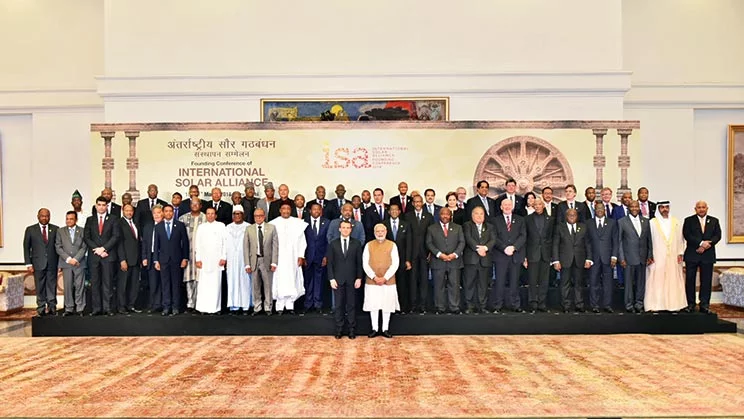…India is one of the strongest supporters of the Paris Agreement. India views the Paris Agreement through the lens of climate justice, equity, and differentiated responsibilities….
INTRODUCTION
Climate change is one of the most pressing issues of the 21st century. It has become a major concern for it, poses threat to ecosystems, economies, human well- being, and common welfare as a whole. Consequently, the world seeks solutions to it through collaborative actions from international frameworks such as the United Nations Framework Convention on Climate Change (UNFCCC), the Rio-de- Janeiro Summit (1992), the Convention on Biological Diversity, and the Paris Agreement. Among these, India holds a crucial and influential position, as the world’s most populous nation and one of the fastest growing major economies in the world. India’s position on Climate Change is shaped by the need to balance between economic growth, poverty eradication, sustainable development, and environmental considerations.
India’s climate change policy is rooted in equity, climate justice, and the principle of Common but Differentiated Responsibilities and Respective Capabilities (CBDR-RC), argues that with per capita emissions still significantly lower than those of the developed countries, a fair distribution of shared efforts and responsibilities must be a focus, so as to allow the developing nations of the Global South, a space to grow economically while advocating for greener pathways and transitioning to environmental considerations. (Michaelowa, 2012).
In recent years, India has demonstrated as growing commitment towards environmental actions, along with ambitious goals for economic development. As the world navigates the complex path of sustainable development, India’s position not only shapes the outcomes of international negotiations but also sets a precedent for the participation of the Global South in influencing global climate governance. This article, thus, mainly discusses India’s stance on the issue of climate change, examining its position, accomplishments, and limitations on the same, and understanding its impact on global climate governance.

INDIA’S STANCE ON GLOBAL CLIMATE ACTION
Since the beginning, the negotiations on climate change have been largely shaped by the divisions between and different perspectives of the Global North and the Global South. Indeed, India has consistently played an active role in the negotiations and established itself as a coalition-builder and protector of the global south’s interests.
At the 1972 United Nations Conference on the Human Environment, India initiated an intellectual tradition in Indian climate policy that pits socio- economic development against environmental protection and accuses the developed countries of the Global North for causing global environmental problems (Vihma, 2011). It was in this Summit, where India pushed for common but differentiated responsibilities. A report by the Centre for Science and Environment called, “Global Warming in an Unequal World”, accused the developed nations of carbon colonialism and stated that developed countries bear the bulk of the responsibility for climate change given their historical emissions and that per capita allocation of emission should be the parameter for dividing responsibility of climate change among the nations (Agarwal and Narain, 1991).
The differences in the historical emissions ultimately were acknowledged in the UNFCCC through the phrase, ‘Common but Differentiated Responsibilities’ in 1992. The Kyoto Protocol to the UNFCCC was formally adopted at Kyoto in December 1997, where countries (Annex 1 countries) agreed to take on individual, quantified, legally binding emissions reduction targets, and Clean Development Mechanism (CDM) was proposed. India was initially reluctant to adopt the CDM measures. Being in the category of developing countries, India ratified the convention to seek benefit from transfer of technology and additional foreign investments when the Kyoto Protocol came into force. India successfully, protected its space for socio- economic development while simultaneously pushing for the developed nations of the Global North to take on more responsibilities. This intellectual tradition has remained steady over the years, and is what some scholars argue, the principal reason why India is seen as a difficult partner in climate negotiations by the Global North (Vihma, 2011).
Moreover, India recognised that projected climate change would have an adverse impact on food production, water supply, natural ecosystems, coastal settlements, energy security, etc. India took a strong position and urged for the transfer of technology and financial support from developed countries to developing countries to be adopted in any formal agreement on climate change. The developed countries in the Copenhagen Summit proposed to create a new agreement asking for practical climate actions from developing countries. In the Copenhagen Summit, India along with the other BASIC nations (Brazil, South Africa, India and China), announced for voluntary targets to reduce carbon emissions by 20-25 percent. India worked closely together through the newly created BASIC alliance to counter the increasing pressure that each of them was facing from a largely united US-led North (Hurrell & Sengupta, 2012). India argued that it was ready to be flexible for climate negotiations except for its three conditions as:
- it would not accept any legally binding emission reduction targets,
- it would not accept any peaking year and,
- it would not allow unsupported mitigation actions to be subject to the same type of scrutiny as those that were externally supported.
Again, at the COP 21 negotiations in Paris, both the Global North and the Global South reflected a willingness to take part in the Paris climate agreement because the agreement provided space and flexibility to determine and decide how much they wish-to and are capable-of contributing to the common collective climate action. India was perceived as one of the pivotal voices at COP 21; its position was in alignment with its balanced approach to meet its climate change goals while pursuing its national interest i.e., to advance its economy and improve the standard of living of its people. India’s commitment to ecologically sustainable economic development is indeed rooted in its age-old civilizational values of respecting nature, incorporating a sense of intergenerational equity and a common humanity (Sharma, 2023). India is one of the strongest supporters of the Paris Agreement. India views the Paris Agreement through the lens of climate justice, equity, and differentiated responsibilities.
Also Read: Economic Sanctions in US Foreign Policy: Effectiveness, Ethics, and Consequences.

INDIA’S INFLUENCE AND IMPLICATIONS ON GLOBAL CLIMATE GOVERNANCE
India’s evolving climate stance has broad implications for international climate governance. This can be further reiterated by discussing the following:
- Shift in Global Climate diplomacy– India plays a key role in representing the Global South in climate negotiations, challenging the traditional power structures. Its emphasis on equity has led to broader support for common but differentiated responsibilities. It stresses that the developing nations should be allowed the space to grow economically, and the developed nations with historical most carbon emissions but bear the bulk of the responsibility for climate mitigation. In this regard, India’s first strategic move is characterised as involving itself to work within the UNFCCC and engaging with multilateral institutions such as the International Energy Agency (IEA).
- Push for Reformed Climate Mechanism– India has consistently voiced concern regarding the inadequacy and conditionality of climate finance from the developed nations. As one of the leading advocates of equity in climate governance, India emphasises on the urgent need to restructure global climate finance systems to better serve the needs of the Global South. India is focusing on ‘triangular’ development partnership with climate in the Global South. A clear example of this is the hosting of G20 Presidency and the Voice of Global South Summit, both hosted by India in 2023. India used these platforms to promote the image of India as a bridge between the Global North mitigation- focused agenda and the Global South’s special focused interests. By pushing for these reforms, India is positioning itself as a voice for systemic change to ensure fairness, equity, and transparency in global finance climate governance.
- A Catalyst for Global South Cooperation– India’s launch of the International Solar Alliance (ISA), in partnership with France in 2015 marked a strategic pivot in climate leadership. ISA is a model of horizontal cooperation which emphasises on shared knowledge, collective procurement, and Global South led climate governance. India’s establishment of the Coalition for Disaster Resilient Infrastructure (CDRI), further its position and role in the global climate governance as a growing leader. With this, India focuses on creating multilateral climate frameworks. The ISA and the CDRI are a prime example of India’s contribution to the global public good, especially for the Global South, along with pushing for its own geopolitical and economic interests.
- Connecting Climate and Economy– India has long maintained that developed nations bear a greater responsibility for climate change. Following it, India has stitched country climate partnerships with various industrialised economies of the world. In 2023, India established a joint statement with the United Arab Emirates on climate change, as well as also signed a Memorandum of Understanding (MoU) with Saudi Arabia on energy cooperation, with a growing emphasis on renewables and steps to accelerate climate transition. These highlight India’s stance in strategically linking climate transition to other issues and allowing India to mitigate climate agenda along with developmental activities.
CONCLUSION
India’s climate strategy underscores the tension between historical emissions and current developmental goals. By demanding greater responsibility from the developed countries of the Global North and simultaneously investing in its own green transition and advocating for a space for the growth of the economies of the Global South, India represents a position of one that is pragmatic, responsible, equitable, and significant in the global climate governance. India’s stance on climate change plays a crucial role in the world- wide endeavour of addressing the issue of climate change and promote sustainable development. India is also a catalyst for the Global South Cooperation on Climate change and has also reiterated firm steps in its domestic policies to tackle the issue of climate change and its impact on the vulnerable regions.
(Priyangshu Chakraborty holds a Master’s degree in Political Science from Assam (Central) University. The views expressed in this article are the author’s own and do not necessarily reflect the official policy or position of Hegemoniq.)





[…] (Also Read: India’s position on Climate Change: The emerging voice of Global South) […]